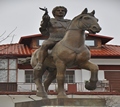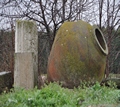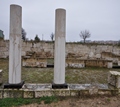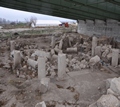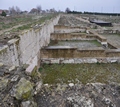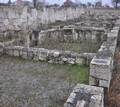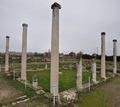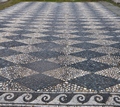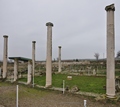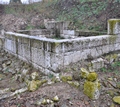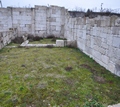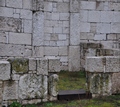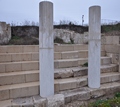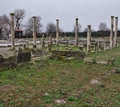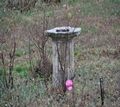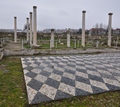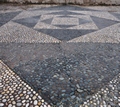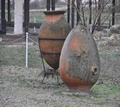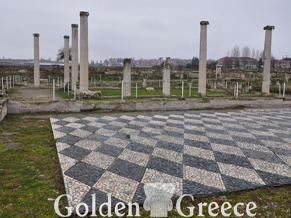
Pella, a small town on the shores of the Thermaic gulf, became the capital of the Macedonian state at the end of the 5th and beginning of the 4th century. BC, replacing Aiges, and soon developed into the most important political, economic and cultural center of all of Greece.
In all probability the choice of the location of the new capital was made by King Archelaos or by Amyntas III mainly for political and economic reasons.
The area of ancient Pella had fertile lands inland and at that time was coastal, which provided easy access in all directions and served both the development of trade and the expansionist policy of the Macedonian kings.
The city of Pella appears for the first time in the ancient sources in Herodotus during the description of the campaign of Xerxes in Greece, while later it is also mentioned by Thucydides. In addition, as testified by other writers, Archelaus placed great emphasis on its administrative and military organization, while many famous poets, such as Euripides, Agathon, Choirilos, and artists, such as the well-known painter Zeuxis, came from southern Greece contributing to its cultural flourishing. The city was organized and expanded during the years of Philip II and Cassander, while Philip II's son, Alexander the Great, was also born here. The form of this oldest city of classical times is not yet fully known, as at present only her cemetery and few architectural remains in the area of the modern irrigation canal have been excavated. It is certain, however, that at the end of the classical era, Pella was now a large city with a regular layout according to the modern system of the period, the hippodamium, with large central streets and vertical streets. Xenophon in his Greek work mentions it as the largest city in Macedonia, an opinion that contradicts Demosthenes' report that Philip was born in a small and insignificant village, although in general this characterization is considered by researchers to be a rhetorical expression, After all, the war that Demosthenes had developed against Macedonia is well known that at the end of the classical era, Pella was now a large city with a regular layout according to the modern system of the period, the hippodamium, with large central streets and vertical streets. Xenophon in his Greek work mentions it as the largest city in Macedonia, an opinion that contradicts Demosthenes' report that Philip was born in a small and insignificant village, although in general this characterization is considered by researchers to be a rhetorical expression, After all, the war that Demosthenes had developed against Macedonia is well known that at the end of the classical era, Pella was now a large city with a regular layout according to the modern system of the period, the hippodamium, with large central streets and vertical streets. Xenophon in his Greek work mentions it as the largest city in Macedonia, an opinion that contradicts Demosthenes' report that Philip was born in a small and insignificant village, although in general this characterization is considered by researchers to be a rhetorical expression, After all, the war that Demosthenes had developed against Macedonia is well known
Pella flourished during the Hellenistic period, the second half of the 4th, 3rd and 2nd centuries BC. From the findings of the excavations we can clearly trace its form, drawing evidence for its fortification art, urban planning, residential, palatial, religious and funerary architecture, and its productive activity. The Hellenistic city of Pella based its development on its establishment as the capital of the Macedonian state but also on its rich commercial traffic. The large-scale market that it possessed, with its production workshops and shops selling ceramics, corroplasty, metal objects, but also food items, channeled these items throughout Western Macedonia and further north.
The monumental building complex of the palace proves, on the other hand, the intention of the Macedonian kings to give a distinct form to their new capital. The private houses with Doric or Ionic peristyles, which often had a second floor, also acquired a monumental form. The wealth of the city and its inhabitants is confirmed by the highly artistic mosaic floors and the colorful decoration of the walls, which is a rare example of preserved Greek painting of the 1st Pompeian style. These works reveal the existence of organized workshops in the Macedonian capital, which gave guidelines to the art of the time. Alongside private life, emphasis was also placed on religious life with the creation of important sanctuaries, which also had workshop spaces,
In 168/167 BC Pella was occupied by the Romans and during the first division of Macedonia it was included in the third portion (regio). With the creation of the Roman province of Macedonia from 148 BC. the seat of the Roman commander was moved to Thessaloniki, so Pella gradually began to lose its power. Its destruction occurred after an earthquake, probably in the first decade of the 1st century BC. Until then, it is certain that there was intense production and construction activity in the city. In 30 BC the Romans organized the new Pella, which was shifted further west, on the plateau that extends north from the so-called Baths of M. Alexander, in the place of the modern Nea Pella.
In the centuries that have passed, the alluvium of the rivers Loudia, Aliakmonas and Axios reshaped the area, so that today the ancient city, after the drying up of the lake of Giannitsa, is 23 km from the shores of Thermaikos. 18th and 19th century travelers described the ruins of Pella and linked them to the written sources. The first excavations in the ancient city took place between 1957-1964. Then the houses with the mosaic floors and part of the palace were revealed, while during the second period of excavations (1976 to the present) the market, part of the palace, other residences, parts of the fortification, sanctuaries and cemeteries were revealed. In the period 1957-1964, the basic restoration works were carried out (walls and Ionic peristyle of the house with the mosaic of Dionysus), while in 1976 a column of the peristyle of the house was restored with the mosaic of the rapture of Helen. In 1998, the maintenance-restoration of the architectural remains of the southern portico of the market began, which will gradually continue in other excavation areas. In recent years, efforts have been focused on the preservation of the architectural remains and the overall promotion of Pella and its wider area.
Editor: Fotini Anastasopoulou










